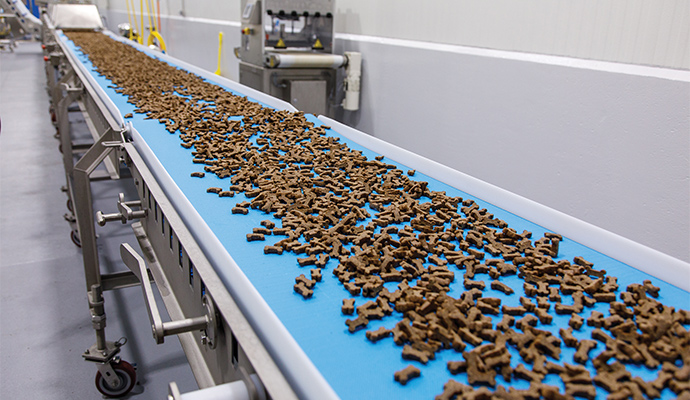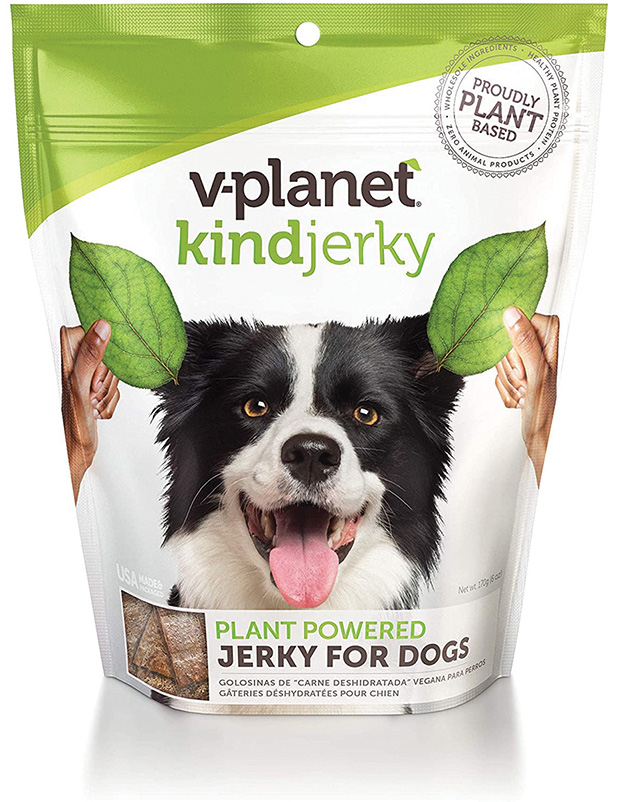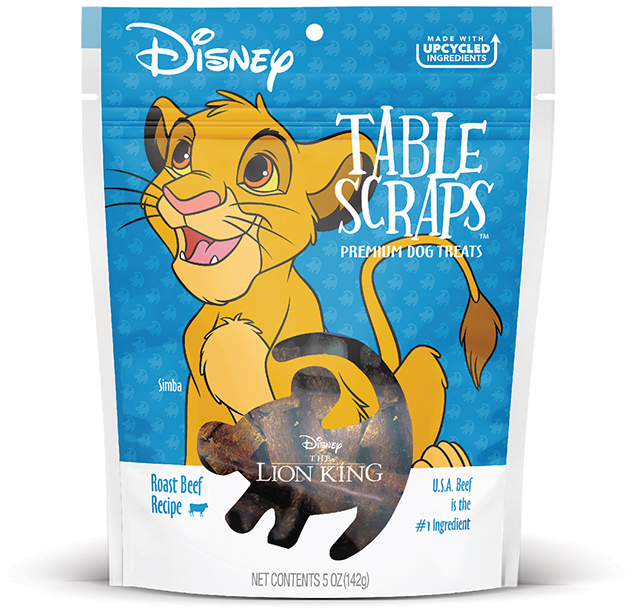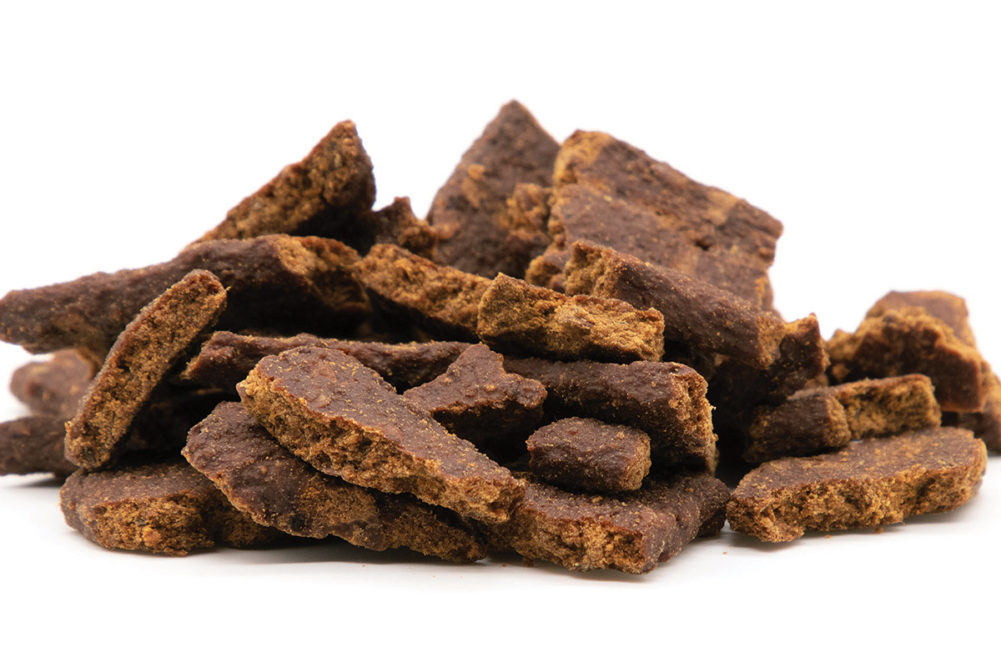This article was published in the September 2021 issue of Pet Food Processing. Read it and other articles from this issue in our September digital edition.
There is now more differentiation in the marketplace than ever before, and pet food and treat processors are embracing new technology and product formulations to gain the attention of discerning pet owners.
“Treats used to be mainly biscuits made of wheat, stamped in a bone shape, and baked at a high temperature,” explained Charlie Bachkora, founder, JAC Pet Nutrition, Olathe, Kan. “These had no nutritional value. Over the years, they have evolved into many different categories and forms. Treats are mirroring the food evolution, with more and unique protein sources, healthier ingredients with less processing (dehydrated and freeze-dried), organic, and all natural.”
Having a huge impact on the evolution of pet treats is people increasingly seeing their role more as a pet parent instead of a pet owner.
 Treat sales are on the rise, with Chicago-based market research firm IRI reporting 32% of its survey respondents purchased more treats for their pets in the second quarter of 2021 than in the first quarter. (Source: NutriSource)
Treat sales are on the rise, with Chicago-based market research firm IRI reporting 32% of its survey respondents purchased more treats for their pets in the second quarter of 2021 than in the first quarter. (Source: NutriSource)
“As pet parents, people view treating their dogs and cats in the same way they view treating their children,” explained Craig Mickey, director of sales, Red Collar Pet Foods, Franklin, Tenn. “They want products that are more natural with ingredients, formulations and textures that they recognize. Just like in human food, packaging needs to deliver freshness and convenience while promoting sustainability.”
Rick Ruffolo, chief executive officer and president, Phelps Pet Products, Rockford, Ill., agreed that humanization is a core driver in the evolution of the pet treat market.
“Dog treats today mirror human food trends in a dynamic commonly referred to as ‘humanization’ featuring ‘superfood’ ingredients, USDA certified organic treats, and sustainable choices such as 100% plant-based (meatless) jerky and treats made with ‘upcycled’ ingredients,” he said.
Another important factor that has played a role in the evolution of pet treats is the way in which consumers use treats.
“Pet parents have found new ways to incorporate treats into their pets’ daily routines,” said Amy McCarthy, ADM Animal Nutrition.
“Pet parents have found new ways to incorporate treats into their pets’ daily routines,” said Amy McCarthy, vice president, pet nutrition, ADM Animal Nutrition, Quincy, Ill. “Treats are used as a snack, a reward to reinforce training behaviors, and as functional foods to provide specific health benefits, much like humans take dietary supplements. Food toppers are also gaining popularity as flavor enhancers and for added moisture.”
Emerging pet treat trends
Perhaps the most notable emerging trend in the pet treat category is health-focused, functional pet treats that deliver specific benefits.
“Niche-specific products, including age-specific treats, immunity-boosting formulations, and treats that support digestive health are in high demand,” said Lindsay Morgan, head of product marketing, Ardent Mills, Denver, Colo. “As such, treats that include Omega 3 fatty acids, probiotics, and ancient grains are becoming popular among pet owners.”
There has been tremendous growth in functional treats that deliver some type of specific benefit beyond simple enjoyment.
“Benefits can be delivered through the ingredients or the form of the treat,” Mickey explained. “If my dog has hip issues, I want a treat that has glucosamine and chondroitin. If I notice some digestive issues, I want a treat that has probiotics and sweet potato. If I am concerned about dental health, I want a treat that is shaped and formed in a way that will help clean my pet’s teeth.”
 For both health and sustainability, some pet owners are embracing vegan treat options for dogs. (Source: v-dog)
For both health and sustainability, some pet owners are embracing vegan treat options for dogs. (Source: v-dog)
Increased consumer interest in clean label ingredients and overall product sustainability is another emerging trend driving the category.
“Consumer demand for clean label ingredients has spurred recipes that are free from artificial colors, flavors, or preservatives, as well as fillers such as corn, wheat and soy,” Ruffolo said. “It also has sparked interest in natural ‘superfood’ ingredients such as sweet potatoes, blueberries, cranberries, and flaxseed, in addition to products that are USDA Certified Organic.”
Other key trends include smaller treats with fewer calories and the use of diverse protein sources such as wild boar, alligator and insects. More sophisticated production methods are also being employed by pet food and treat processors.
“Technological capabilities have played a role in achieving the right consistency for texture and palatability,” McCarthy said. “Today’s treats are baked, extruded, injection molded, freeze-dried, and dehydrated. Additionally, pet owners can find recipes and bake-at-home mixes to make their own treats.”
The acceleration of these emerging trends can be attributed in part to the COVID-19 pandemic.
“Pandemic-related growth in the pet treat market is similar to the human market,” commented Adam Martodam, marketing director, NutriSource Pet Foods, Perham, Minn. “With people spending more time at home, there were more opportunities for trips to the pantry/snacking.”
The COVID-19 pandemic has changed the way consumers value their own food choices and that trend appears to apply to the pet products they purchase as well.
“More time spent at home with pets during the past year means that pet owners were likely more tuned into their companions’ needs,” Morgan said.
New pet treat options
Consumers have responded favorably to innovation in the pet treat category, and a wide variety of new pet treat options are becoming available. In the first six months of this year alone, dozens of brands have launched a range of new pet treat, topper and supplement products.
“Ingredients like superfoods, antioxidants, CBD and collagen are booming and mirroring human health trends,” said Anja Skodda, HAPPYBOND.
“There have been lots of functional treats with benefits like joint health, immune support, skin and coat health, and anxiety relief,” said Anja Skodda, founder, HAPPYBOND, Venice, Calif. “Ingredients like superfoods, antioxidants, CBD and collagen are booming and mirroring human health trends.”
The company has recently released its HAPPYBITES range of freeze-dried treats made with high-quality single protein sources including salmon and rabbit.
The line between treats and supplements is getting increasingly blurry. One example of that is JAC Pet Nutrition’s dog treats featuring superfoods.
“At JAC Pet, we have our Superfood Treats with 260 mgs of Omega 3 and 6 in each nugget,” Bachkora said. “This helps support joints, the heart, skin and coat. We have almost as much Omega 3 and 6 as supplement companies.”
More treat options are also incorporating plant-based protein sources.
“One example is a vegan dog sausage made with millet, lentils, green algae and vegetables,” Morgan said. “The nutritional and marketing benefits of ancient grains are now more relevant than ever in the pet food industry. Organic and gluten-free ancient grain options are available in whole kernels, flours or custom blends, delivering unique flavor and appearance to pet treats.”
Recently, Phelps Pet Products released its Disney TableScraps™ dog treat line.
 Upcycled ingredients and a meatless variety support the sustainability story behind this new Disney-branded line of dog treats. (Source: Phelps Pet Products)
Upcycled ingredients and a meatless variety support the sustainability story behind this new Disney-branded line of dog treats. (Source: Phelps Pet Products)“This line is a collaborative effort between Disney and Phelps Pet Products to provide dog treats featuring meat-first ‘upcycled ingredients’ (thus, the selection of the name ‘Table Scraps’), USDA certified organic recipes, 100% plant-based (meatless) recipes, and clean-label ingredient panels,” Ruffolo explained.
Other notable new pet treat offerings include v-dog’s kindjerky meatless jerky treats made with animal-free ingredients, and Bocce’s Bakery Dailies, a line of functional treats that address dental health, immune system health, digestion, and more.
“Sales of CBD pet products are still going strong, too, although they’re not yet approved by the FDA,” said Brad Allen, innovation and new product development, Bow Wow Labs, Novato, Calif.
Challenges of pet treat production
Staying current with changing consumer demands is an ongoing process for pet food and treat processors.
“Challenges include meeting multiple customers’ demands in a fast-growing market,” said Amy Tesinsky, senior research and innovation scientist, Petsource by Scoular, Seward, Neb. “Another challenge is having the flexibility to manufacture single-ingredient treats (freeze-dried chicken, freeze-dried beef liver) as well as complex formulas with superfoods, grains, as well as utilizing sustainable proteins such as bean flour, alligator, insects, etc.”
Packaging is a challenge for processors with the ever-growing range of pet treat formats and ingredients.
“As consumers prioritize convenience over cost for their pet food and treat purchases, processors are tasked with more product and packaging changeovers required for small-batch production runs,” Morgan said. “In addition, pet owners want more sustainable packaging and resealable options that retain freshness, which can be challenging.”
Another challenge is managing complexity in the production process while ensuring quality and food safety.
 Meeting the quality, variety and ingredient demands for today’s pet treat market requires a cooperative effort between processors and suppliers. (Source: Red Collar Pet Foods)
Meeting the quality, variety and ingredient demands for today’s pet treat market requires a cooperative effort between processors and suppliers. (Source: Red Collar Pet Foods)
“Managing a diversity of unique ingredients requires an experienced team of procurement and food science experts working with quality suppliers to ensure that our ingredients meet our demanding specifications,” Mickey explained.
The sourcing of ingredients required for certain brand claims can limit who can manufacture those products.
“Human-grade ingredient requests are growing,” Allen remarked. “However, many of the traditional pet food and treat processing facilities cannot produce human-grade ingredients and maintain the claim of a product being made with human-grade ingredients.”
Advancements in technology
New technology has facilitated the production of increasingly complex treat formulations.
“Processing lines are being updated with technology that delivers real-time data for temperature and moisture monitoring and general information related to the line’s efficiency,” Morgan explained. “In addition, updated equipment designs that focus on sanitation and reduced contamination help ensure product quality for pet treat manufacturers.”
Human-food production offers some options.
“The most recent technology that is being used is enrobing technology, which is used primarily in the human confectionery and baking industries,” Allen said. “We are now seeing treats that are enrobed with peanut butter, yogurt-based coatings, and carob (chocolate replacement ingredient for pets).”
Martodam said more pet treats coming from human food manufacturers increases the overall processing options for pet brands.
“Pet broth would be an example of this where liquid broth products are now being used as a form of treating along with palatability enhancers to dry food,” Martodam explained.
“We see innovation in pet treats presenting new opportunities as manufacturers use existing technology to explore unique treat shapes with new combinations of ingredients for product differentiation and to meet customer expectations,” McCarthy said.
Processors are also innovating by finding new applications for existing technology.
“We see innovation in pet treats presenting new opportunities as manufacturers use existing technology to explore unique treat shapes with new combinations of ingredients for product differentiation and to meet customer expectations,” McCarthy said. “Extrusion technology is ever evolving, offering new and exciting applications. In the future, we will likely see 3D printing for treat production.”
Ruffolo said he believes it is the combination of equipment technology and the availability of new ingredients that offers brands a competitive advantage.
“While there always will be the opportunity to purchase new machinery or expand capacity, the major dog treat category advances have come in the ingredient market as manufacturers now have access to ‘cleaner,’ organic and ‘benefit-driven’ ingredients,” Ruffolo said. “Creating new recipes using these new ingredients while leveraging proprietary processes are some of the keys to winning in the market.”
Gaining consumer attention
In such a crowded market, it is vital for pet treat processors to differentiate themselves from the competition.
“To gain the consumer’s attention, you have to have something new and different,” Bachkora explained. “Plus, you need to get the product on the shelf and communicate a clear message about what is in the bag.”
Allen agreed that it is important to launch products into the marketplace that are truly differentiated, and then properly promote them.
“Having a strong campaign wrapped around social/digital media, aggressive public relations strategy, and developing communities of new customers [is important],” Allen said. “Turning your new users and customers into product/brand evangelists can be an extremely strong asset in the marketing arsenal. Trial/sampling programs are critical to driving new users – all these components need to be integrated and leveraged with reach and frequency thresholds to launch and sustain a new product.”
The rise of e-commerce has been instrumental in helping many pet treat processors differentiate themselves from their competitors and gain market share.
“Digital marketing and e-commerce have made it easier for brands of all sizes to reach their target audience in a much more efficient and effective manner,” Ruffolo said. “Building brand awareness, seeking consumer ratings/input, and creating ‘buzz’ all can be accomplished via the digital/e-commerce experience – well before a product ever can be purchased in store.”
“Pet product sales from e-commerce are now approaching 30% of all sales,” said Brad Allen, Bow Wow Labs.
Content creation and influencer marketing can also be effective strategies for increasing brand awareness.
“Influencer and celebrity marketing is booming, as well as educational content that demonstrates product benefits,” Skodda said. “Many consumers turn to trusted brands that stand for clean and innovative nutrition. Recommendations from vets are still trending and science is playing a bigger role.”
Despite the advantages, e-commerce does present some challenges for pet treat brands.
“One of the drawbacks to online shopping is that it’s more challenging to convey appearance, including color and shape, as well as texture and aroma in a two-dimensional virtual space,” McCarthy commented. “Consumers have more opportunity to experience new treats in store, so there could be a hurdle for first-time purchases through e-commerce – though it’s very effective for repeat buyers. Brands also have to consider the logistics of shipping costs, extra materials for packaging, and potential issues with shelf life if new products are slow to move off the shelf.”
Ultimately, the benefits of e-commerce far outweigh any disadvantages for pet treat brands, making it vital for brands to understand and embrace the channel.
“Pet product sales from e-commerce are now approaching 30% of all sales,” Allen noted. “It continues to grow and outpace any other channel. Having a keen understanding of the nuances within e-commerce is also critical when investing into this space and making it a profitable channel. Brands need to understand that this phenomenon is not going away. It is here to stay – the consumer is driving that activity and brands need to fish where the fish are.”
Keep up with the latest pet food trends on our Trends page.



